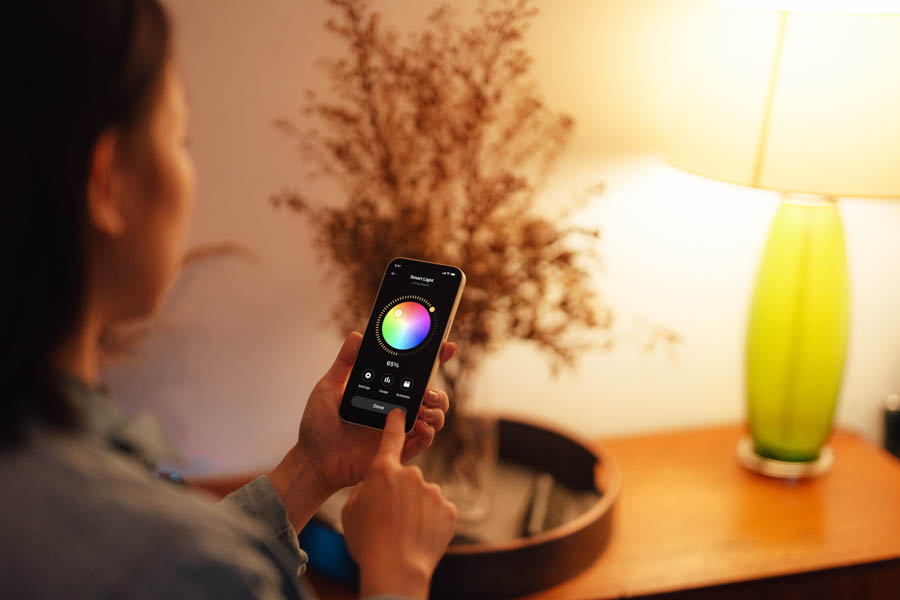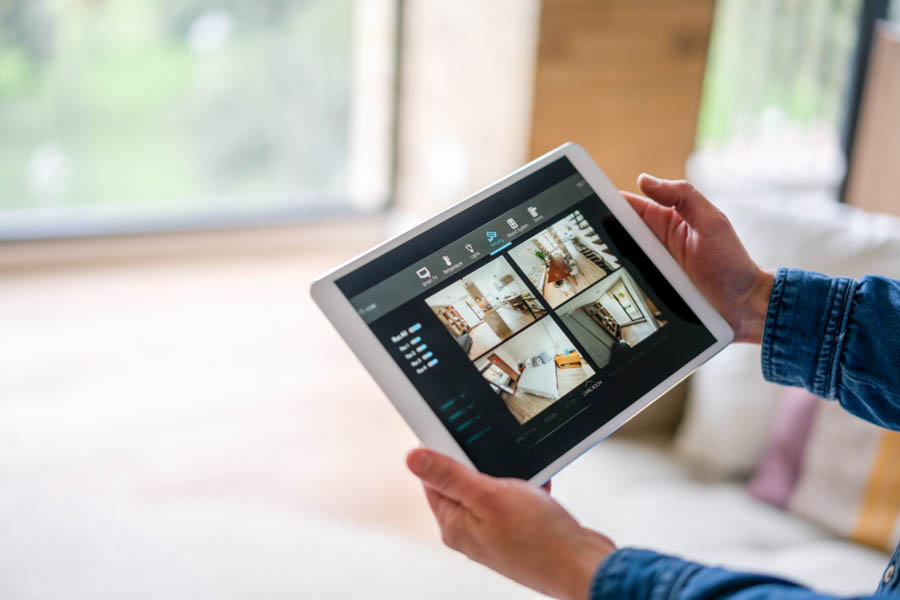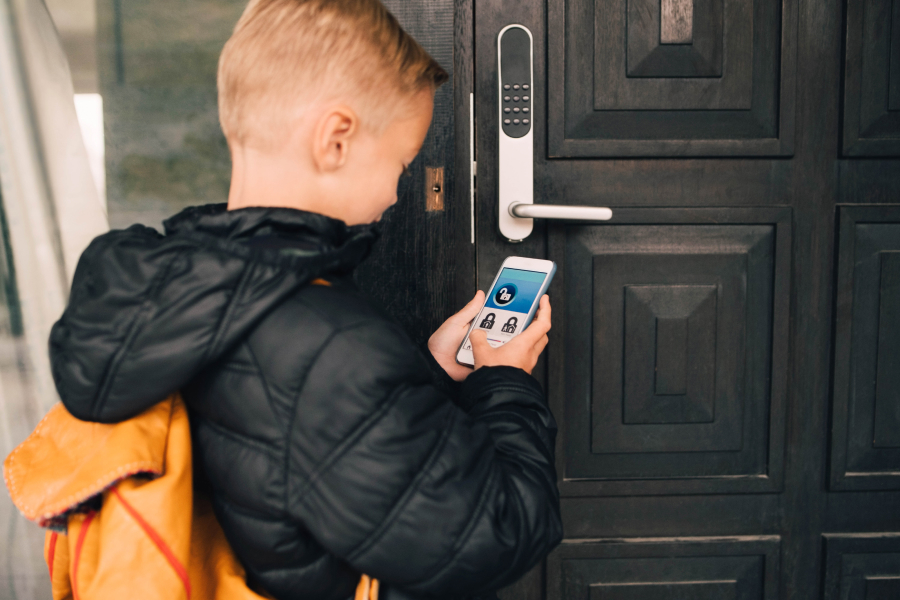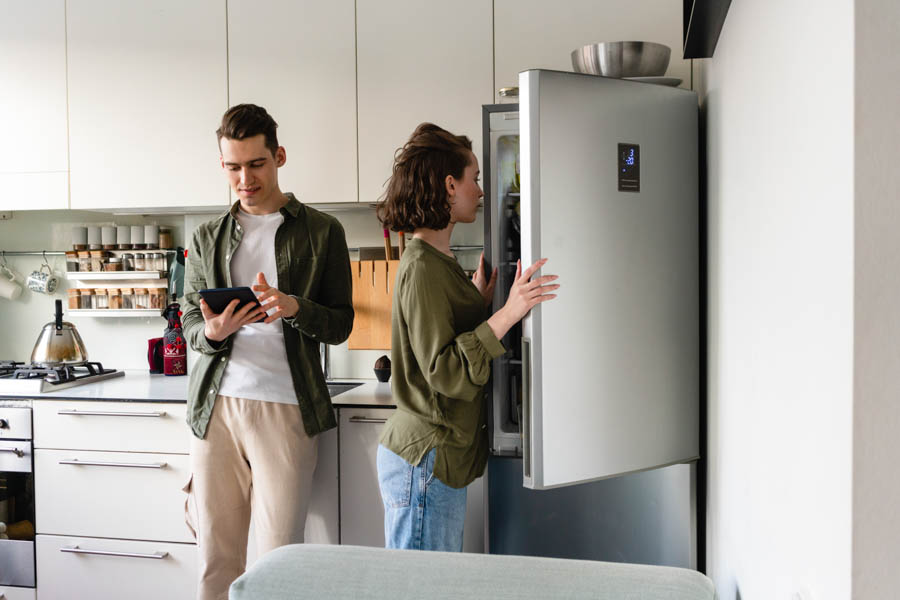From refrigerators to locks, almost anything in your home can be upgraded with a smart home device. Here’s a guide to get started.

Once the exclusive domain of the wealthy and technologically inclined, smart home tools and systems are becoming more accessible and new products are constantly coming on the market. Here’s a brief smart home guide to help get you started with smart devices and connected homes.
What’s a smart home?
Essentially, a smart home uses technology and internet connectivity to automate tasks and make its functions more efficient and convenient. Some examples are thermostats that control the temperature, lights that turn off when you leave a room, or controls that configure your entertainment system for the best movie experience.
“While ‘smart home’ is a concept that’s been around for a decade, new technology has made it more common,” says Mark Benson, head of SmartThings, Samsung’s home automation company.
In the last few years, smart home devices have become easier to install and use, and they’re becoming more affordable. You can equip your home with a few basic smart home devices for less than $100. Installation can be as simple as downloading an app and screwing in a smart light bulb or outlet adaptor. And as remote work looks here to stay, home offices offer another catalyst for smart home tech adoption.
“Consumers are reimagining their homes and thinking about them as places of relaxation, safety and now work,” Benson says. “People want more from their homes, and smart home technology and home automation are helping them make their homes better. That has led to a rapid adoption of smart home tech in just the last few years.”
Smart home apps and automation
Most smart home devices usually come with a corresponding app or platform, or work with a major smart home ecosystem, like Samsung’s SmartThings, Google Home or Apple’s HomeKit. Third-party manufacturers often offer their own app and indicate compatibility with the larger systems (“Works with Alexa,” for example). If you’re adding to a system, confirm that your additions are compatible with the components you already own.
Recently, Alexa, Apple Home, Google Home, and Samsung SmartThings have adopted a common smart home software language called Matter. Matter promises to allow devices to work together across different platforms and ecosystems. If it works as advertised, you could, for example, pair Google Nest controls with Apple HomeKit devices. But Matter or no Matter, it pays to do a little homework before adding to your system.
With these devices and apps, you can set up what’s often called ‘home automation,’ like timing lights to turn on and off when you’re on vacation, or shutting down the home for bedtime.
“In my house, we have some automation through the SmartThings app that shuts the house down at night,” Benson says. “We call it ‘Good night.’ So, when we’re going to bed, we can just say, ‘Alexa, Good night,’ and the home automation turns off the lights and locks the door.”
Types of smart home tech
If you’re looking to explore the world of smart home tech, below are a few common starting points.
Smart lights and switches

Smart lights, including bulbs and switches, are one of the easiest and least expensive entry points to smart home technology. You can control them either remotely, via an app on your smartphone when you’re away from home or with a voice assistant when you are at home.
“Installing smart lighting is as easy as putting in a smart light bulb and downloading an app to run it,” Benson says. “You can get a lot of energy savings from turning off lights when no one is in the room,” he says. “You can also set the right mood for watching a movie without going around and hitting every light switch in the room.” You can use smart lights indoors or outdoors, so you can easily control lights on the porch, in the living room or in your bedroom by touching a screen or speaking to a voice assistant.
Smart thermostats

Smart thermostats, like Nest or Ecobee, are one of the top-selling smart home device types in the U.S. About 30% of North American homes use one, and they now account for half of annual thermostat sales, according to the Department of Energy.
Smart thermostats allow you to create programmable temperature settings based on your schedule and needs. They’ll turn off the AC or heat while you’re at work and turn it on an hour before you get home each day, so you aren’t wasting money heating and cooling an empty house.
“Smart thermostats use sensors to detect when you’re home, and they only run the HVAC when you are there,” Benson says. “They can save you a lot of money on your energy bill.”
Security cameras

You can get indoor or outdoor cameras that keep an eye on your house. Outdoor cameras, specifically video doorbells like Ring and Nest, have become extremely popular smart home ideas, Benson says. They can let you answer your door wherever you are, whether it’s the other side of the door or the other side of the country. What’s more, Zillow research shows that listings that mention doorbell cameras can help a home sell about five days faster than those without, so adding one could prove to be a worthwhile investment if you’re thinking about selling in the near future.
Video doorbells have sensors that detect motion and turn on the camera when someone steps on your porch. The camera then streams live video to your phone, so you can see who is at the door and even speak to them through your phone. So you can talk to the FedEx guy while you are at work and tell him where to leave your package. And then you can keep an eye out for porch pirates who might steal your package once he leaves it. “Video doorbells add a lot of security and give you peace of mind,” Benson says.
Tip: Visit Zillow’s Home Security Systems and Products page for top-rated systems you can compare and purchase.
Smart locks

Smart door locks let you lock and unlock your house with the tap of a finger or voice command — no key needed. You can unlock the house for a guest or the housekeeper while you’re not home. You can set up entry codes that work for only a certain timeframe, so you control who has access to your house. Some smart locks allow you to monitor who comes into your house, in real time, so you can see if your kids got home from school or if the dog walker showed up.
Smart home security systems
Smart home security setups have come down in price in recent years, with many popular systems costing only a few hundred dollars. These systems usually feature sensors to monitor your windows, and many come equipped with smart locks, doorbell cams, or offer them as add-ons. Some systems also offer smoke and carbon monoxide detectors and professional monitoring. They can either be professionally installed or DIY, hard-wired into your home or battery powered.
Smart appliances

Even your appliances can now hook up to the internet and do amazing things. You can get smart refrigerators that send a notification to your phone when the use-by dates of your yogurt are near, or send a live video stream of the inside of the fridge while you’re at the grocery store, so you can see if you’re low on milk or lunchmeat. You can get washing machines and dryers that allow you to run a cycle remotely from your phone, so you can dry a load of clothes for 10 minutes longer without getting off the sofa. These are really next-level smart home devices.
Smart home privacy and cybersecurity
Unfortunately, smart home devices come with some well-documented privacy concerns. Amazon keeps a copy of everything you say to Alexa, and Google has been keeping the recordings from its voice assistant to train its artificial intelligence. Even your smart light bulbs could be recording data about you that goes back to the bulb’s manufacturer. Remember, you almost always have to enter some personal information to activate a new device, so the manufacturer possesses that data. For now, surrendering some of your data might just be a trade-off for this futuristic technology.
Smart home devices also come with some well-documented cybersecurity risks. While it may seem like no big deal if someone gains access to your smart bulb, bad actors can get creative and wreak havoc. At a minimum, take basic security precautions with these systems. Password-protect your wifi, maintain good passwords, keep everything up-to-date, and when possible use two-factor authentication.
How to get started with a smart home system
It’s easy to scale smart home technology. Buy one or two devices, then expand your smart home one device at a time. “Our statistics show that 74% of people with smart homes started with one device,” Benson says. “They didn’t start with a whole system.” He says Samsung’s research shows most people start with smart lights, then add a smart thermostat, then a smart lock and security cameras.
“Lights are extremely accessible,” he says. “As you add more devices to your smartphone over time, your smart home grows with you.”
Don’t be intimidated by smart home technology. Dipping a toe into home automation can make your home more comfortable, safer and maybe even more valuable.

